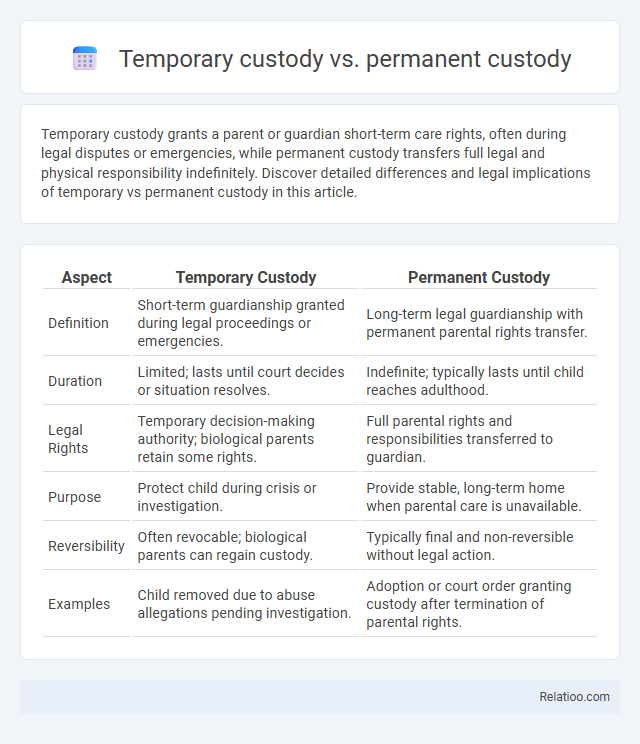Temporary custody grants a parent or guardian short-term care rights, often during legal disputes or emergencies, while permanent custody transfers full legal and physical responsibility indefinitely. Discover detailed differences and legal implications of temporary vs permanent custody in this article.
Table of Comparison
| Aspect | Temporary Custody | Permanent Custody |
|---|---|---|
| Definition | Short-term guardianship granted during legal proceedings or emergencies. | Long-term legal guardianship with permanent parental rights transfer. |
| Duration | Limited; lasts until court decides or situation resolves. | Indefinite; typically lasts until child reaches adulthood. |
| Legal Rights | Temporary decision-making authority; biological parents retain some rights. | Full parental rights and responsibilities transferred to guardian. |
| Purpose | Protect child during crisis or investigation. | Provide stable, long-term home when parental care is unavailable. |
| Reversibility | Often revocable; biological parents can regain custody. | Typically final and non-reversible without legal action. |
| Examples | Child removed due to abuse allegations pending investigation. | Adoption or court order granting custody after termination of parental rights. |
Understanding Temporary Custody
Temporary custody grants You the legal right to care for a child for a limited period, often during emergencies or while awaiting court decisions. It differs from permanent custody, which establishes long-term guardianship and decision-making authority, and custodial custody, which generally refers to physical custody arrangements. Understanding temporary custody is essential for ensuring the child's safety and well-being during transitional phases.
What is Permanent Custody?
Permanent custody grants one parent or guardian full legal rights and responsibilities for a child indefinitely, typically following a court's assessment of the child's best interests. This arrangement overrides temporary custody, which is a short-term solution while the court evaluates long-term plans. Understanding the implications of permanent custody helps you ensure the child's stability and welfare in your custody decisions.
Legal Differences: Temporary vs Permanent Custody
Temporary custody grants a caregiver limited rights to care for a child during a specific period or under particular circumstances, usually until a court decision or parent resolves the issue. Permanent custody transfers full parental rights and responsibilities to the custodian indefinitely, often in cases of neglect or abandonment, and requires a court's final ruling. Legal distinctions between temporary and permanent custody revolve around duration, scope of parental rights, and the court's intent to either provide short-term care or establish a long-lasting custodial arrangement.
Reasons for Granting Temporary Custody
Temporary custody is granted to protect a child's immediate safety and well-being during situations such as parental neglect, abuse, or pending court decisions. Unlike permanent custody, which establishes long-term guardianship, temporary custody addresses urgent needs while investigations or legal processes are underway. Your child's welfare is prioritized to ensure a stable environment until a permanent custody agreement is determined.
Criteria for Permanent Custody Decisions
Permanent custody decisions hinge on factors such as the child's best interests, the stability and safety provided by the potential guardian, and the capacity to meet the child's emotional, educational, and physical needs. Courts assess the child's relationship with the caregiver, the history of any abuse or neglect, and the likelihood of reunification with biological parents. Your involvement in demonstrating a safe, nurturing environment significantly influences the court's ruling for permanent custody.
Duration and Limitations of Temporary Custody
Temporary custody grants You limited guardianship rights for a short duration, often until a court establishes a permanent arrangement or an emergency resolves. Unlike permanent custody, which provides long-term or lifelong responsibility for a child's care, temporary custody restricts decision-making authority and visitation rights based on the situation's urgency. Custodial status varies by jurisdiction but generally distinguishes between temporary arrangements focused on immediate welfare and permanent custody emphasizing stability and ongoing parental duties.
Rights and Responsibilities in Both Custody Types
Temporary custody grants a caregiver limited rights and responsibilities to make day-to-day decisions for a child during a specific period, often while legal guardianship or parental rights are being determined; this includes providing basic needs and ensuring safety without the authority to make long-term decisions. Permanent custody confers full legal rights and responsibilities, allowing the custodian to make enduring decisions about education, healthcare, and welfare, effectively replacing parental rights in all aspects. Custodial arrangements revolve around the allocation of physical and legal custody, with rights in temporary custody being provisional and supervised, whereas permanent custody ensures stable, ongoing authority and accountability for the child's upbringing.
Process for Transitioning from Temporary to Permanent Custody
Transitioning from temporary custody to permanent custody involves a legal process where the court evaluates factors such as the child's best interests, parental fitness, and permanent living arrangements. You must file a petition for permanent custody, attend hearings, and provide evidence supporting the shift from temporary supervision to long-term guardianship. The court's decision ensures stability while prioritizing the child's safety and well-being.
Impact on Children: Temporary vs Permanent Custody
Temporary custody provides stability for children during transitional periods but can cause uncertainty and emotional stress due to its limited duration. Permanent custody offers long-term security and consistent care, which supports emotional development and attachment, crucial for a child's well-being. Your understanding of these distinctions helps ensure decisions prioritize the child's best interests and psychological health.
Frequently Asked Questions about Custody Types
Temporary custody grants You short-term legal guardianship during emergencies or transitional periods, allowing immediate decision-making for the child's welfare. Permanent custody establishes long-term legal responsibility, giving a guardian full rights and duties until the child reaches adulthood or the court modifies the arrangement. Custodial arrangements vary widely but primarily define who has the authority to care for and make decisions about the child's upbringing, education, and health.

Infographic: Temporary custody vs Permanent custody
 relatioo.com
relatioo.com